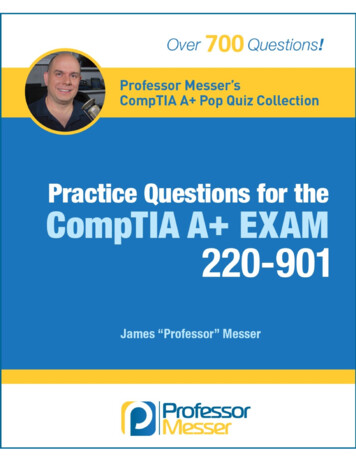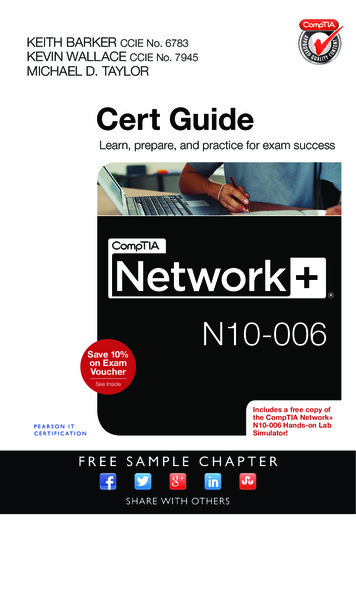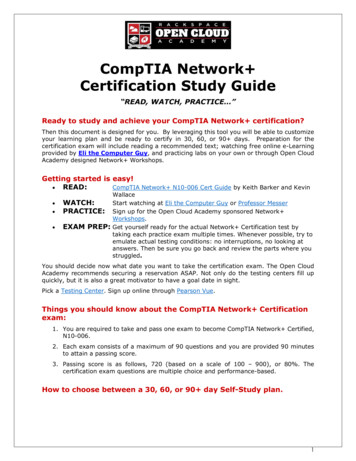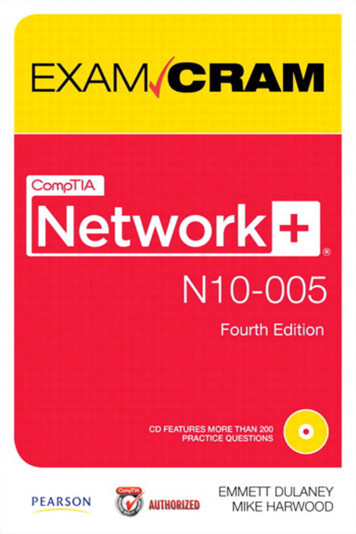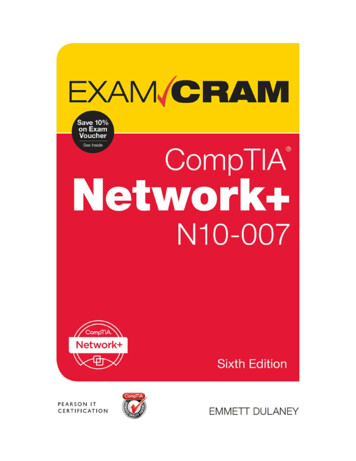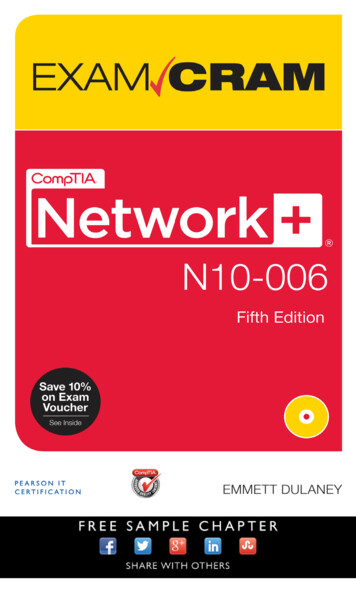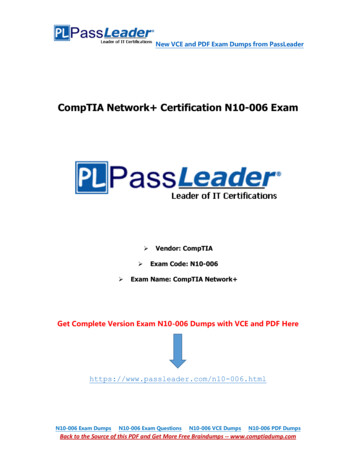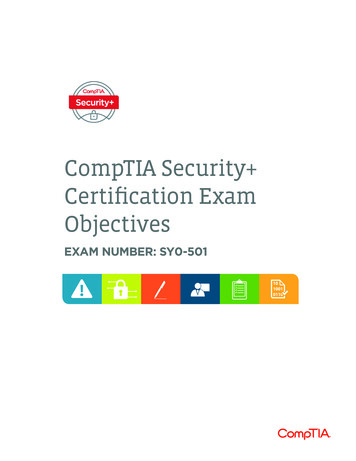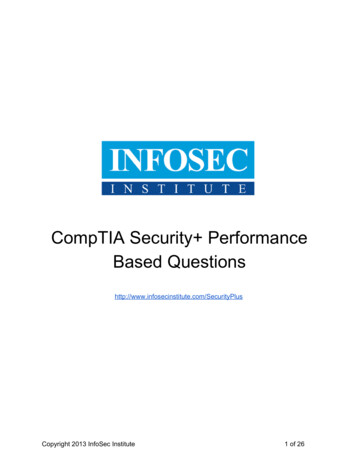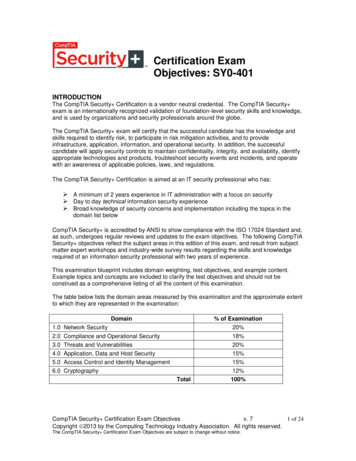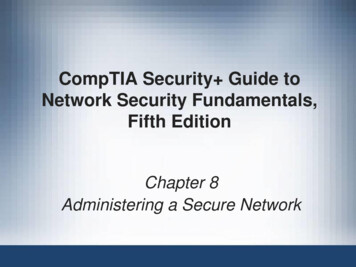
Transcription
CompTIA Security Guide toNetwork Security Fundamentals,Fifth EditionChapter 8Administering a Secure Network
Objectives List and describe the functions of common networkprotocols Explain how network administration principles canbe applied Define different network applications and how theycan be securedCompTIA Security Guide to Network Security Fundamentals,Fifth Edition Cengage Learning 20152
Common Network Protocols Protocols– Rules for communication– Essential for proper communication betweennetwork devices Transmission Control Protocol/Internet Protocol(TCP/IP)– Most common protocol suite used for local areanetworks and the Internet– Comprises several protocols that all functiontogetherCompTIA Security Guide to Network Security Fundamentals,Fifth Edition Cengage Learning 20153
Common Network Protocols IP– Protocol that functions primarily at Open SystemsInterconnection (OSI) Network Layer (Layer 3)– Provides network addressing and routing TCP– Transport Layer (Layer 4) protocol– Establishes connections and ensures reliable datatransport between devices TCP/IP uses a four layer architecture– Network Interface, Internet, Transport, ApplicationCompTIA Security Guide to Network Security Fundamentals,Fifth Edition Cengage Learning 20154
Common Network ProtocolsCompTIA Security Guide to Network Security Fundamentals,Fifth Edition Cengage Learning 20155
Common Network Protocols Several basic TCP/IP Protocols:––––––Internet Control Message Protocol (ICMP)Simple Network Management Protocol (SNMP)Domain Name System (DNS)File transfer and storage protocolsNetBIOSTelnet A new and more secure version of IP is designedto replace the current versionCompTIA Security Guide to Network Security Fundamentals,Fifth Edition Cengage Learning 20156
Internet Control Message Protocol(ICMP) ICMP– Used by devices to communicate updates or errorinformation to other devices– ICMP messages are divided into two classes: Informational and query messages Error messagesCompTIA Security Guide to Network Security Fundamentals,Fifth Edition Cengage Learning 20157
Internet Control Message Protocol(ICMP) ICMP message fields– Type Identifies general message category– Code Gives additional information about the Type field– Checksum Verifies message integrity– Message Body Contains information about the specific ICMPmessageCompTIA Security Guide to Network Security Fundamentals,Fifth Edition Cengage Learning 20158
Internet Control Message Protocol(ICMP)CompTIA Security Guide to Network Security Fundamentals,Fifth Edition Cengage Learning 20159
Internet Control Message Protocol(ICMP) Attacks that that advantage of ICMP––––Network discoverySmurf attackICMP redirect attackPing of deathCompTIA Security Guide to Network Security Fundamentals,Fifth Edition Cengage Learning 201510
Simple Network Management Protocol(SNMP) Used to manage network equipment and issupported by most network equipmentmanufacturers Allows administrators to remotely monitor, manage,and configure network devices Functions by exchanging management informationbetween network devices Each SNMP-managed device has an agent or aservice– Listens for and executes commandsCompTIA Security Guide to Network Security Fundamentals,Fifth Edition Cengage Learning 201511
Simple Network Management Protocol(SNMP) Agents are password protected– Password is known as a community string Security vulnerabilities were present in SMNPversions 1 and 2– Version 3 uses usernames and passwords alongwith encryption to address vulnerabilitiesCompTIA Security Guide to Network Security Fundamentals,Fifth Edition Cengage Learning 201512
Domain Name System (DNS) A TCP/IP protocol that maps IP addresses to theirsymbolic name The DNS database is organized as a hierarchy– Database consists of the name of a site and acorresponding IP number Database is distributed to many different serverson the Internet– To prevent bottlenecking and to ensure efficiencyCompTIA Security Guide to Network Security Fundamentals,Fifth Edition Cengage Learning 201513
Domain Name System (DNS)CompTIA Security Guide to Network Security Fundamentals,Fifth Edition Cengage Learning 201514
Domain Name System (DNS) DNS is often the focus of attacks– DNS poisoning substitutes fraudulent IP address Can be done in local host table or external DNSserver Latest edition of DNS software prevents DNSpoisoning– Attacker asks the valid DNS for a zone transfer A zone transfer allows attacker access to network,hardware, and operating system informationCompTIA Security Guide to Network Security Fundamentals,Fifth Edition Cengage Learning 201515
File Transfer Protocols TCP/IP protocols are used for transferring files– File transfer protocol (FTP) - used to connect to anFTP server– Trivial file transfer protocol (TFTP) - a “light” versionof FTP that uses a small amount of memory Methods for using FTP on local host computer– From a command prompt– Using a web browser– Using an FTP clientCompTIA Security Guide to Network Security Fundamentals,Fifth Edition Cengage Learning 201516
File Transfer Protocols Using FTP behind a firewall can present challenges– FTP uses two ports Port 21 is the FTP control part Port 20 is the data port– FTP active mode Client’s firewall may sometimes drop packets on Port20 (the data channel connection)– FTP passive mode The client sends a PASV command to the commandchannel and the server responds with the TCP portnumber to use to establish the data channelCompTIA Security Guide to Network Security Fundamentals,Fifth Edition Cengage Learning 201517
File Transfer ProtocolsCompTIA Security Guide to Network Security Fundamentals,Fifth Edition Cengage Learning 201518
File Transfer Protocols FTP vulnerabilities– Does not use encryption– Files transferred using FTP are vulnerable to manin-the-middle attacks Secure transmission options over FTP– Secure sockets layer (FTPS) encrypts commands Uses SSL or TLS to encrypt commands sent over thecontrol port (port 21); data port may not be encrypted– Secure FTP (SFTP) Uses only a single TCP port instead of two ports All data and commands are encryptedCompTIA Security Guide to Network Security Fundamentals,Fifth Edition Cengage Learning 201519
File Transfer Protocols (cont’d.) Secure Copy Protocol (SCP)– An enhanced version of Remote Copy Protocol(RCP)– Encrypts files and commands– File transfer cannot be interrupted and then resumedin the same session Session must be completely terminated and restarted– Found mainly on Linux and UNIX platformsCompTIA Security Guide to Network Security Fundamentals,Fifth Edition Cengage Learning 201520
Storage Protocols As storage capacities have grown, mostorganizations have turned to using a storage areanetwork (SAN)– A dedicated network storage facility that providesaccess to data storage over a high-speed network iSCSI (Internet Small Computer SystemInterface) - an IP-based storage networkingstandard for linking data storage facilities– Can transmit data over LANs, WANs, and theInternetCompTIA Security Guide to Network Security Fundamentals,Fifth Edition Cengage Learning 201521
Storage Protocols Fibre Channel (FC) - a high-speed storagenetwork protocol that can transmit up to 16 Gbps Fibre Channel over Ethernet (FCoE)– A variation of FC that encapsulates Fibre Channelframes over Ethernet networks– Allows FC to use fast Ethernet networks whilepreserving the FC protocol FC zones - a built-in security mechanism– There are two types: FC hard zone FC soft zoneCompTIA Security Guide to Network Security Fundamentals,Fifth Edition Cengage Learning 201522
NetBIOS NetBIOS (Network Basic Input/Output System)– A transport protocol used by Microsoft Windowssystems– Allows applications on separate computers tocommunicate over a LAN– An attacker who determines that NetBIOS is runningcan use an application to gather informationregarding the network in order to design an attack– It is recommended to disable NetBIOS or used onlyif necessary on specific devices that require itCompTIA Security Guide to Network Security Fundamentals,Fifth Edition Cengage Learning 201523
Telnet Telnet– An older TCP/IP protocol for text-basedcommunication– Also a terminal emulation application that runs on alocal computer Connects to a server on a network– Telnet does not encrypt data and many securityweaknesses have been uncovered within theprotocol– It is recommended that Secure Shell (SSH) be usedinstead of TelnetCompTIA Security Guide to Network Security Fundamentals,Fifth Edition Cengage Learning 201524
Network Administration Principles Administering a secure network can be challenging Rule-based management approach– Relies on following procedures and rules– Procedural rules are the authoritative and prescribeddirection for conduct Procedural rules dictate technical rules– Technical rules address: Device securityMonitoring and analyzing logsNetwork design managementPort securityCompTIA Security Guide to Network Security Fundamentals,Fifth Edition Cengage Learning 201525
Device Security Device security involves:– Establishing a secure router configuration– Implementing flood guards Secure router configuration– Router operates at Network Layer (Layer 3) Forwards packets across computer networks– Routers can perform a security function Can be configured to filter out specific types ofnetwork trafficCompTIA Security Guide to Network Security Fundamentals,Fifth Edition Cengage Learning 201526
Device SecurityCompTIA Security Guide to Network Security Fundamentals,Fifth Edition Cengage Learning 201527
Device Security Flood guard– Protects against denial of service (DoS) attacks– SYN flood attack A type of DoS attack that takes advantage of theprocedures for initiating a session– A flood guard controls a device’s tolerance forunanswered service requests Administrator can set a maximum number of“developing” connections– Commonly found on firewalls, IDSs, and IPSsCompTIA Security Guide to Network Security Fundamentals,Fifth Edition Cengage Learning 201528
Monitoring and Analyzing Logs Security logs– Can reveal types of attacks that are being directed atthe network and if attacks were successful Access logs– Provide details regarding requests for specific files Audit logs– Used to record which user performed an action Event logs– Document any unsuccessful events and the mostsignificant successful eventsCompTIA Security Guide to Network Security Fundamentals,Fifth Edition Cengage Learning 201529
Monitoring and Analyzing Logs A routine review of logs helps to:––––Identify security incidentsPolicy violationsFraudulent activityOperational problems Logs can be useful for:– Performing auditing analysis– Supporting the organization’s internal investigations– Identifying operational trends and long-termproblemsCompTIA Security Guide to Network Security Fundamentals,Fifth Edition Cengage Learning 201530
Monitoring and Analyzing Logs Logs can provide documentation that theorganization is complying with laws and regulatoryrequirements Firewall log items to be examined– IP addresses rejected and dropped– Probes to ports that have no application services onthem– Source-routed packets– Suspicious outbound connections– Unsuccessful loginsCompTIA Security Guide to Network Security Fundamentals,Fifth Edition Cengage Learning 201531
Monitoring and Analyzing LogsCompTIA Security Guide to Network Security Fundamentals,Fifth Edition Cengage Learning 201532
Monitoring and Analyzing Logs Problems with log management:– Multiple devices generating logs– Very large volumes of data– Different log formats A solution to log management is to use acentralized device log analyzerCompTIA Security Guide to Network Security Fundamentals,Fifth Edition Cengage Learning 201533
Network Design Management Several network design management principlesshould be followed to ensure a secure network Network separation– Provides separation between different parts of thenetwork– Example: order entry network segment cannotaccess the network that controls heating and cooling Option to accomplish network separation– Physically separate users by connecting them todifferent switches and routersCompTIA Security Guide to Network Security Fundamentals,Fifth Edition Cengage Learning 201534
Network Design Management Loop protection– Refer to Figure 8-7 for a description of a broadcaststorm– Host Z wants to send frames to Host X– Switch A floods network with the packet– Packet travels down the network segments to theSwitches B and C– Switches B and C add Host Z to their lookup tables– Both switches flood Segment 2 looking for Host X They receive each other’s packets and flood themback out againCompTIA Security Guide to Network Security Fundamentals,Fifth Edition Cengage Learning 201535
Network Design ManagementCompTIA Security Guide to Network Security Fundamentals,Fifth Edition Cengage Learning 201536
Network Design Management Loop protection can prevent broadcast storms– Uses IEEE 802.1d spanning tree algorithm (STA)– Determines which switch has multiple ways tocommunicate with host– Determines best path and blocks other paths Virtual LAN (VLAN) management– Network may be segmented into logical groups ofphysical devices through VLAN– Scattered users may be logically grouped together: Regardless of which switch they are attached toCompTIA Security Guide to Network Security Fundamentals,Fifth Edition Cengage Learning 201537
Network Design Management General principles for managing VLANs– Configure empty switch ports to connect to anunused VLAN– Change any default VLAN names– Configure the ports on the switches that pass taggedVLAN packets to explicitly forward specific tags– Configure VLANs so that public devices are not on aprivate VLANCompTIA Security Guide to Network Security Fundamentals,Fifth Edition Cengage Learning 201538
Port Security Disabling unused interfaces– Turn off ports not required on a network device thatare not required– A switch or router without port security allowsattackers to connect to unused ports and attack thenetwork– All interfaces should be secured before switch isdeployed– The network administrator should issue shutdowncommand to each unused portCompTIA Security Guide to Network Security Fundamentals,Fifth Edition Cengage Learning 201539
Securing Network Applications andPlatforms Several network applications and platforms requirespecial security considerations:– IP telephony– Virtualization– Cloud computingCompTIA Security Guide to Network Security Fundamentals,Fifth Edition Cengage Learning 201540
IP Telephony A shift to an all digital technology infrastructure isunderway– Converges voice and data traffic over a single IPnetwork– IP telephony adds digital voice clients and new voiceapplications to a data based network An IP telephony application can be easilydeveloped that personalizes the treatment ofincoming calls– Calls can be selectively forwarded or blockedCompTIA Security Guide to Network Security Fundamentals,Fifth Edition Cengage Learning 201541
Virtualization Virtualization– A means of managing and presenting computerresources without regard to physical layout orlocation Host virtualization– An entire operating system environment is simulated– Virtual machine - a simulated software-basedemulation of a computer– The host system runs a hypervisor that manages thevirtual operating systems and supports one or moreguest systemsCompTIA Security Guide to Network Security Fundamentals,Fifth Edition Cengage Learning 201542
Virtualization Virtualization advantages– New virtual server machines can be made available(host availability) and resources can easily beexpanded or contracted as needed (host elasticity)– Can reduce costs Fewer physical computers must be purchased andmaintained– Can provided uninterrupted server access to users Supports live migration which allows a virtual machineto be moved to a different physical computer with noimpact to usersCompTIA Security Guide to Network Security Fundamentals,Fifth Edition Cengage Learning 201543
Virtualization Virtualization advantages (cont’d.)– Test latest patches by downloading on a virtualmachine before installing on production computers– A snapshot of a particular state of a virtual machinecan be saved for later use– Testing the existing security configuration (securitycontrol testing) can be performed using a simulatednetwork environment– A suspicious program can be loaded into an isolatedvirtual machine and executed (sandboxing) If malware, only the virtual machine will be impactedCompTIA Security Guide to Network Security Fundamentals,Fifth Edition Cengage Learning 201544
Cloud Computing Cloud computing– A model for enabling convenient, on-demandnetwork access to a shared pool of configurablecomputing resources– It is a pay-per-use computing model Customers pay for only the resources they need Types of clouds––––Public cloudCommunity cloudPrivate cloudHybrid cloudCompTIA Security Guide to Network Security Fundamentals,Fifth Edition Cengage Learning 201545
Cloud Computing Three service models of cloud computing– Software as a Service (SaaS) Vendor provides access to the vendor’s softwareapplications running on a cloud infrastructure– Platform as a Service (PaaS) Consumers install and run their own specializedapplications on the cloud computing network– Infrastructure as a Service (IaaS) Vendor allows customers to deploy and run their ownsoftware, including OSs and applicationsCompTIA Security Guide to Network Security Fundamentals,Fifth Edition Cengage Learning 201546
Summary TCP/IP is the most common protocol for LANs andthe Internet Protocols for transferring files– FTP, FTPS, SFTP, SCP Storage area network (SAN) is a dedicated networkstorage facility that provides access to data storageover a high-speed network Router configuration must provide a securenetwork environment Flood guard defends against denial-of-serviceattacksCompTIA Security Guide to Network Security Fundamentals,Fifth Edition Cengage Learning 201547
Summary Networks can be configured to provide separationand increased security Securing ports is an important step in networkmanagement– Unused ports should be disabled New network applications that have specialsecurity considerations– IP telephony– Virtualization– Cloud computingCompTIA Security Guide to Network Security Fundamentals,Fifth Edition Cengage Learning 201548
CompTIA Security Guide to Network Security Fundamentals, Fifth Edition Chapter 8 Administering a Secure NetworkFile Size: 826KB
